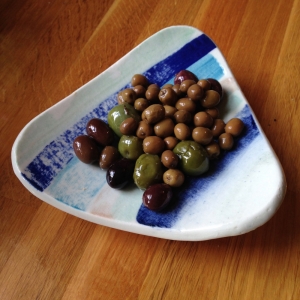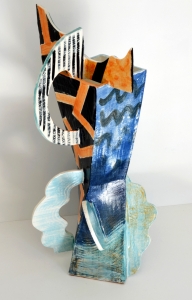ceramics, olives, squirrels
A long time ago, arriving anywhere in Spain meant being greeted by the smell of tobacco and coffee. Nowadays, with smoking restrictions in place, it is just the coffee you can just about whiff as you get out of Málaga airport and walk into the dry heat of Andalucía. The drive from Málaga to our destination, the city of Úbeda in Jaén, was a trip through a dry but varied landscape of mountains, valleys and great stretches of olive groves as far as the eye can see. This is the region that produces the most olive oil in the world, alone producing more than the second world producer of oil, Italy. Something like 20% of world production comes from here. There are about 60 million olive trees in this fertile land, and a squirrel could travel happily across the whole province without once touching soil (they claim). Anyway, the photograph above was taken from the hill of Úbeda looking down and across towards the Sierra de Cazorla. The next image is of a squirrel.
The cultivation of olive trees goes back centuries in the different Mediterranean cultures, and includes the Greek, the Phoenician and the Assyrian – even the Bible mentions it over 400 times, since it was used not only as food but as a light source. Of course, the oil had to be stored, and what better way to contain it than the ceramic amphora or jug.
In Spanish a potter is known as an alfarero, a word that comes from the Arabic “alfahar” meaning “ceramic” and “ero” denoting a profession, and without doubt the best known alfarero in Úbeda is Tito. And pottery has been made in Ubeda for over a thousand years; there have been many influences and styles that have left their mark, and at Tito’s ceramic workshop you can experience absolute fidelity to traditional forms as well as a decorative eclecticism that incorporates and recreates the contributions of each historical period, from Iberian geometries to colourful Baroque via Arab greens and the blues of the Renaissance.
From the cool oasis of Tito’s you can walk to one of the most striking Renaissance collection of buildings in Spain – the Vázquez de Molina square where you can visit the Palacio de las Cadenas (so named after the decorative chains which once hung from the façade), the chapel of El Salvador and the Basílica de Santa María. The interior of the chapel is stunning, built as a burial place for the local nobility in 1536, it is a Spanish architectural jewel with a main altar that forces one to sit down and contemplate.
The town lends its name to a common figure of speech in Spanish, andar por los cerros de Úbeda (literally ‘to walk around the hills of Úbeda’), meaning ‘to go off at a tangent’, which yours truly did by succumbing to a mild case of shingles. Luckily the local chemist is very helpful so no doctor was required, but it did mean that any consumption of local delicacies such as perdiz en escabeche (partridge), andrajos (a stew made with flour, oil, tomato, pepper and rabbit) and paté de aceituna (olive paté) had to be postponed, as did any drinking of the local Torreperogil wine.
This small sacrifice was soon forgotten with the next stage of the trip. The drive to Jerez de la Frontera meant a brief stop at Écija, the Frying Pan of Spain, and though it turned out be hot enough, the temperature was not as high as in the UK at the time. Something of the dryness of the Spanish landscape and its underlying human endeavour and activity inspired a set of pots once back at the workshop – an abstract interpretation with a marked personality. What do you think?
However, back on the road, the landscape changed gradually the further West we drove, and by the time we were nearing Jerez the fields were white. Albariza is a chalky soil that retains moisture within while forming a dry pale crust above that prevents any drying. This is ideal for the growing of the Palomino grape used in the production of sherry and brandy. The result is a stripy landscape of green and white, grape and soil.
A tour of the Barbadillo sherry makers in the port of Sanlucar de Barrameda taught us that manzanilla is made there whereas fino is made in Jerez. Because of the sea breeze that enters the giant bodegas where the maturing takes place, manzanilla has a slightly salty tang. Manzanilla is camomile, which is another aroma typically found in this type of sherry, and where better to sample some than at a bar in the centre of the city. After admiring the cathedral-like building that houses the hundreds of soleras (oak barrels) of manzanilla we headed back to Jerez.
Bar Juanito is a cool and airy space clad inside and out with locally-made ceramic tiles where they serve all the sherries along with their specialities, artichoke and deep-fried whitebait. As with most towns and cities in Andalucía tiles are used to decorate buildings on the outside, such as the tower of the church of San Miguel, and to help keep interiors at a lower temperature, for example in the courtyards and patios of houses, and in public and domestic rooms.
But if you are feeling the heat then go to the beach. The one at Santa Maria del Puerto is wide and clean and, despite the fact that it is the Atlantic, easy to swim in. The view across the bay allows you a glimpse of Cadiz in the distance.
In a further attempt to link ceramics, however tenuously, with this blog and the trip to Spain, here is an image of a large pot made two or three years ago which was inspired by the movements of a flamenco dance. It is called Flamenco Pot.
Should you want to meet any of the ceramics face to face, keep in mind that other than the workshop in Ledbury there are outlets too in St Ives, Worcester, Cambridge and London – addresses and contact details on the website. Click here to go to the website.
Hasta luego, amigos.





















